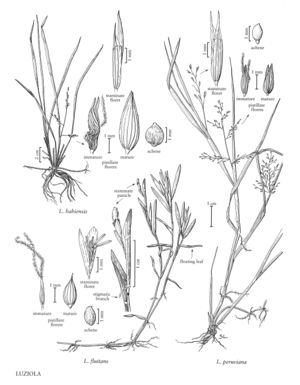Difference between revisions of "Luziola bahiensis"
FNA>Volume Importer |
imported>Volume Importer |
||
| (4 intermediate revisions by 2 users not shown) | |||
| Line 4: | Line 4: | ||
|publications= | |publications= | ||
|common_names=Brazilian watergrass | |common_names=Brazilian watergrass | ||
| + | |special_status={{Treatment/ID/Special_status | ||
| + | |code=I | ||
| + | |label=Introduced | ||
| + | }} | ||
|basionyms= | |basionyms= | ||
|synonyms= | |synonyms= | ||
| Line 17: | Line 21: | ||
-->{{Treatment/Body | -->{{Treatment/Body | ||
|distribution=Fla.;Ala.;Miss. | |distribution=Fla.;Ala.;Miss. | ||
| − | |discussion=<p>Luziola bahiensis is native from the Caribbean south to Argentina. It has been found at scattered locations in southern Louisiana, Mississippi, Alabama, and north-western Florida. It grows in wet places or shallow water along streams and lakes.</p> | + | |discussion=<p><i>Luziola bahiensis</i> is native from the Caribbean south to Argentina. It has been found at scattered locations in southern Louisiana, Mississippi, Alabama, and north-western Florida. It grows in wet places or shallow water along streams and lakes.</p> |
|tables= | |tables= | ||
|references= | |references= | ||
| Line 26: | Line 30: | ||
-->{{#Taxon: | -->{{#Taxon: | ||
name=Luziola bahiensis | name=Luziola bahiensis | ||
| − | |||
|authority=(Steud.) Hitchc. | |authority=(Steud.) Hitchc. | ||
|rank=species | |rank=species | ||
| Line 34: | Line 37: | ||
|family=Poaceae | |family=Poaceae | ||
|illustrator=Sandy Long | |illustrator=Sandy Long | ||
| + | |illustration copyright=Utah State University | ||
|distribution=Fla.;Ala.;Miss. | |distribution=Fla.;Ala.;Miss. | ||
|reference=None | |reference=None | ||
|publication title= | |publication title= | ||
|publication year= | |publication year= | ||
| − | |special status= | + | |special status=Introduced |
| − | |source xml=https:// | + | |source xml=https://bitbucket.org/aafc-mbb/fna-data-curation/src/200273ad09963decb8fc72550212de541d86569d/coarse_grained_fna_xml/V24/V24_61.xml |
|subfamily=Poaceae subfam. Ehrhartoideae | |subfamily=Poaceae subfam. Ehrhartoideae | ||
|tribe=Poaceae tribe Oryzeae | |tribe=Poaceae tribe Oryzeae | ||
Latest revision as of 17:24, 11 May 2021
Plants stoloniferous, emergent or immersed. Culms 10-50 cm, suberect to erect. Leaves mostly basal or scattered along the culms, not conspicuously floating or streaming in the current; sheaths glabrous or ciliate; ligules to about 6 mm, lanceolate, acuminate; pseudopetioles sometimes present; blades 3-30(39) cm long, 1-6 mm wide, glabrous or puberulent. Inflorescences panicles; pedicels capillary. Staminate panicles 4-6 cm, terminal, with 9-17 spikelets; staminate florets 4-8 mm; lemmas lanceolate, faintly 5-9-veined; paleas similar, 3-veined; anthers 6, 2-4 mm, linear. Pistillate panicles to about 12 cm, arising from the lower nodes of the culms, all or mostly exserted, with 9-17 spikelets; branches slender, divergent to reflexed; pistillate florets 3-5 mm, caducous; lemmas 8-13-veined, acuminate or caudate; paleas similar, 6-8-veined; stigmas 2-4 mm. Achenes 1.5-2.2 mm, ovoid or broadly ellipsoid, lightly to moderately striate, somewhat lustrous. 2n = 24.
Distribution
Fla., Ala., Miss.
Discussion
Luziola bahiensis is native from the Caribbean south to Argentina. It has been found at scattered locations in southern Louisiana, Mississippi, Alabama, and north-western Florida. It grows in wet places or shallow water along streams and lakes.
Selected References
None.
